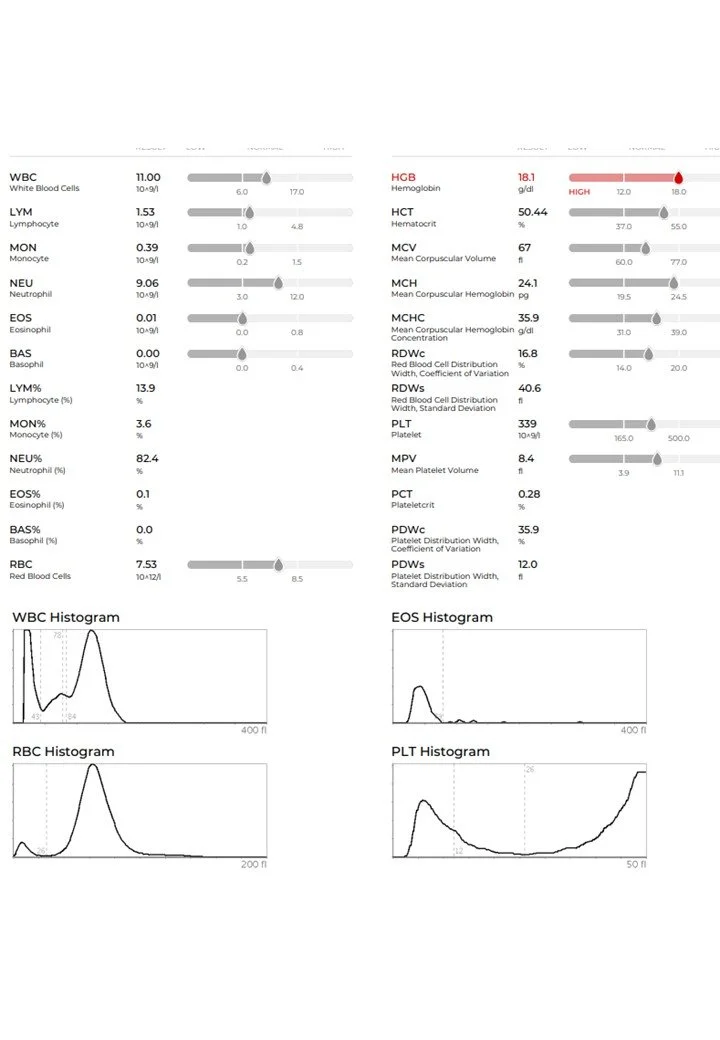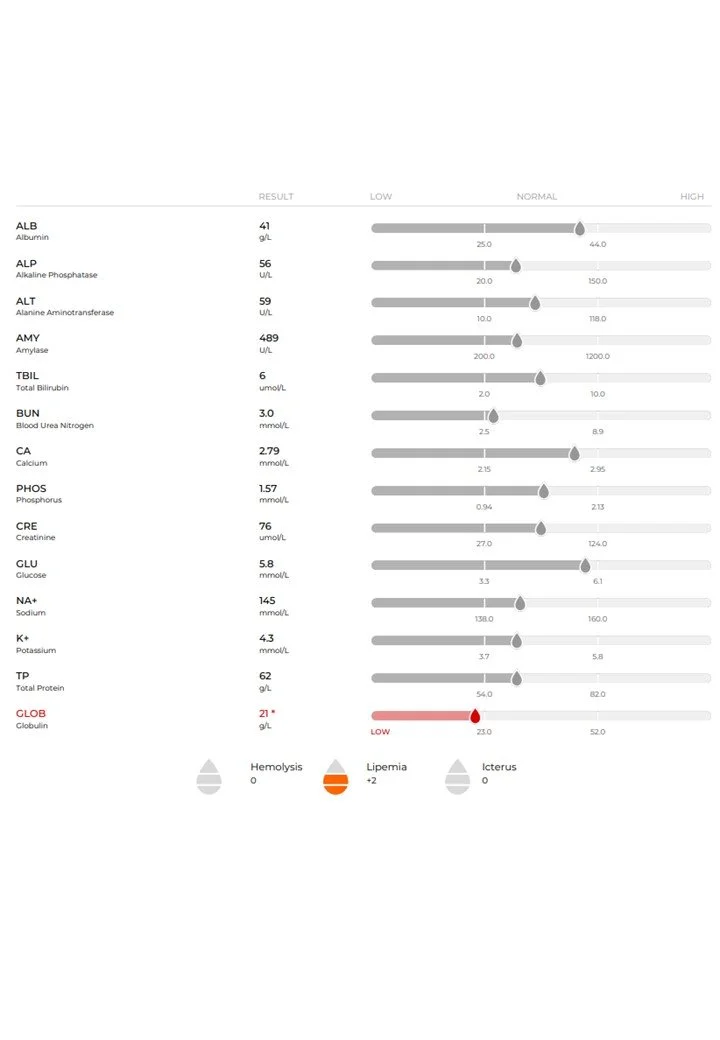Important to Know: What are Blood Tests and what can they tell us?
Having a blood sample is often the first step in a veterinary investigation. The vet will then give you an interpretation of the result along with a copy. The results may make perfect sense to you, or, they may appear like a foreign language. Here we outline the key parameters we use to guide our decisions from the most common blood test – a comprehensive biochemistry and haematology.
Quick Read (30 Seconds):
Haematology examines white blood cells and red blood cells.
Biochemistry examines organ related bio-markers. We interpret set bio-marker patterns to evaluate the vital organs of the body.
Blood results given an indication as to what part of the body is likely to be affected by a disease, and how the body is responding to that disease.
Some blood profiles give obvious patterns to confirm a diagnosis, whilst other blood profiles create more questions than answers and lead to more tests being required.
Bio-markers and blood parameters can change very quickly and so repeat blood tests close together may be needed
What are blood tests?
Blood tests are an essential tool when investigating the health of your pet because organ function cannot always be evaluated by touch and looking alone. There is usually not “one test” to identify a problem and so a series of blood tests may be needed. Navigating what test is needed can be complex and so we aim to make sure all options and benefits are discussed with you before submitting any samples for analysis.
How do they work?
Blood samples are taken and the results are analysed against a “normal range”. What this range truly means is that, between the stated values, 95% of the general population would fall when there is no likely chance of a problem with that specific parameter.
When a parameter falls above or below the normal range, we identify potential problems and start piecing together the diagnostic picture.
As with many biological systems, there are always exceptions, “normal” parameters that are actually abnormal for the individual, and abnormal parameters which are actually normal to the individual. This individual variation can be challenging to identify and interpret so repeated sampling may be advised.
A Quick Guide to blood interpretation:
Outlining every disease profile and pattern is not the purpose of this article. There are many text books written on the topic. Instead, below is a quick summary of some common diagnoses made with the comprehensive blood test. We have split this into haematology and biochemistry.
Haematology – White and Red Blood cells
Haematology looks specifically at white blood cells and red bloods cells. Generally, we experience elevations in white blood cells and reductions in red blood cells when problems arise. In the converse this is usually related to less common diseases and each will be explained by your vet when such events occur.
White Blood Cells:
The white blood cells are further divided into individual cell types
- Neutrophils Raised when bacterial are involved
- Lymphocytes Raised when long term inflammation, viral or cancer is to be considered
- Eosinophils Raised if parasites or allergies are likely
- Monocytes Raised in stress related conditions or long term inflammation
- Basophils Generally low relevance for most conditions
The easiest pattern to recognise is one of a systemic bacterial infection - this is evident when the neutrophils are raised above the normal limits
Red Blood cells:
The most important parameters in the RBC section for general assessment is the total red blood cell count, and the haematocrit. The other parameters relate to the size of the red blood cell, the haemoglobin concentration and this reflects the age of the red blood cells – all relevant if a patient is anaemic.
- Total Red Blood Cell Count. The total number of red blood cells in the sample. This goes up and down relating to dehydration status (up) or blood loss and destruction (down). Some breeds have naturally high red blood cell count, such as greyhounds
- Haematocrit This is very similar to the total red blood cell count, and moves up and down for much the same reason. This can also be referred to the packed cell volume (PCV) and represents all cells within the blood sample taken.
Biochemistry
Biochemistry examines specific markers present within the blood sample. Each marker is associated with certain organs. Whilst some markers give clear indications of the problems likely faced, as is true with much of biology, every marker can have multiple reasons as to why they could be outside normal ranges. With this being understood, we often link markers to give more information. The clustering below are not always the order the results are presented on a blood sample. The outlines that follow are a simple interpretation but act as the baseline assessment before more complex interpretation begins.
Protein Levels
TP – Total Protein TP is made up of both Albumin and Globulin. Even if the result is normal, deviation of the individual components may indicate a problem.
ALB – Albumin High suggests dehydration or fluid loss; Low suggests leaking – this could be intestines, kidneys, or other locations
GLOB – globulin Generally related to immune function, low suggests leaking; high could indicate a cancerous problem, or severe infection
The Liver
ALP – Alkaline Phosphatase
ALT – Alanine Aminotransferase
ALP and ALT tend to move in similar directions. Released from the liver when cells are damaged, elevations can be a results of primary liver issues, or secondary problems such as drug related elevations e.g. Steroids, or other diseases like Cushings Disease.
TBIL – Total Bilirubin
TBIL indicates a certain level of liver function. Any deviation from normal parameters warrants investigations as a reduction in liver function can predispose the body to toxins or other issues that the liver is central to maintaining.
Pancreatic enzymes
AMY – Amylase
The pancreas is a very sensitive organ. Any gastrointestinal issue has the potential to cause a pancreatitis and an increase in amylase. Recovery from a general disease will allow recovery of the pancreas, however, specific tests, notable Canine and Feline Pancreatic Lipase Immunoreactivity (cPLI/fPLI) are used when a primary pancreatitis is suspected.
Kidneys
BUN – Blood Urea Nitrogen
CRE – Creatinine
Kidney failure, kidney damage, renal insufficiency are common occurrences in our patients. Whenever the kidneys are involved we see elevations in the renal parameters BUN and CRE. This elevation is known as azotaemia. Azotaemia does not mean kidney failure, and instead, its presence can then be divided into 3 scenarios
- Pre renal azotaemia dehydration, poor kidney perfusion such as heart disease
- Renal azotaemia primary kidney disease, kidney failure
- Post renal azotaemia blockage of the bladder or urinary tract, urinary tract infections
In any instance, where we have the presence of azotaemia, a urine sample is essential to help interpret the results.
Diabetes and Stress
GLU – Glucose
Glucose elevates in three most common scenarios, stress related elevation, recent feeding, or diabetes. The rule of thumb is a low-level increase suggests stress or a recent meal whilst very high is strongly suggestive of diabetes.
To determine which is likely, the wider blood sample is examined, a urine sample is essential, and potentially a repeat blood test is needed.
Diabetes is a complex disease and was a feature article a few months ago.
Electrolytes
CA – Calcium
PHOS – Phosphorous
Na+ - Sodium
K+ - Potassium
Changes in the electrolytes can be very complex. Multiple factors influence their levels such as kidney health, hydration, certain cancers, diet, thyroid functions, to mention a few.
Should there be minor changes, these are likely to be corrected with fluid support. If there are major changes, these suggest a much greater problem and can have an impact on other organ functions. In this scenario we would more than likely have the patient hospitalised and on intensive care.
The test results are all normal, was this a waste of money?
Absolutely not! If any patient is unwell then healthy organ function is vital to support the body in its quest for recovery. Many severe illnesses can be ruled out with a good set of blood results and this is a really good level of information to hold. A normal blood result is a high chance of recovery.
Despite this, in certain situations, some illnesses do not touch the primary organs assessed in a comprehensive blood test. In these cases, a normal blood results rules out a large number of possible causes and helps narrow our focus on other illnesses. Examination of the whole patient in conjunction with the blood test is always needed to continue to piece.
Conclusion
A blood sample is often the first step in any disease investigation. Haematology concerns the physical cells within the blood, whilst biochemistry examines specific biomarkers related to particular organs. Whilst some patterns strongly indicate certain diseases, others help guide our investigations and what next steps we would need to undertake to investigate further. A normal blood test is a great thing and never a waste of money or effort!



